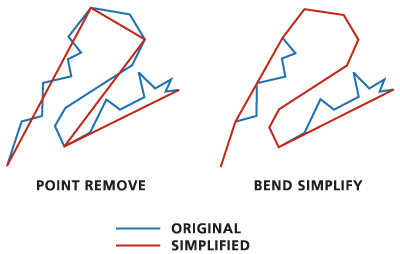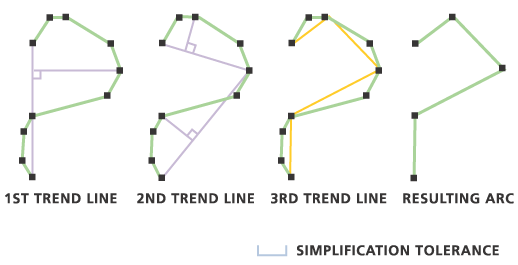Simplification of linear features or polygon boundaries is a type of generalization operation (Esri, 1996) that removes extraneous bends and small intrusions and extrusions from a line or polygon boundary without destroying its essential shape. In the Simplify Line Or Polygon tool, the POINT_REMOVE and BEND_SIMPLIFY operators simplify both linear features and non-orthogonal polygon boundaries.

Choosing which operator to use
POINT_REMOVE applies a published algorithm (Douglas and Peucker, 1973) with enhancements. It is a fast, simple line simplification algorithm. It keeps the so-called critical points that depict the essential shape of a line and removes all other points. The algorithm connects the end nodes of an arc with a "trend line". The distance of each vertex to the trend line is measured perpendicularly. Vertices closer to the line than the tolerance are eliminated. The arc is divided by the vertex farthest from the trend line, which makes two new trend lines. The remaining vertices are measured against these lines, and the process continues until all vertices within the tolerance are eliminated (see the diagram below).

POINT_REMOVE is efficient for data compression and for eliminating redundant details; however, the line that results may contain sharp angles and spikes that reduce the cartographic quality of the line. Use POINT_REMOVE for small amounts of data reduction or compression and when you don't need high cartographic quality.
BEND_SIMPLIFY applies shape recognition techniques that detect bends, analyze their characteristics, and eliminate insignificant ones. A bend that's too narrow will be widened slightly to satisfy the tolerance. The resulting line is more faithful to the original and shows better cartographic quality.
Choosing a suitable tolerance
The tolerance value set by Weed Tolerance determines the degree of simplification. To produce cartographic outputs, set the tolerance for these operators equal to or greater than the threshold of separation (the minimum allowable spacing between graphic elements). For other display or for data reduction, trial and error may be required to find a suitable tolerance. Using the same tolerance, POINT_REMOVE produces a rougher and more simplified result than BEND_SIMPLIFY.
Improving the results
When using POINT_REMOVE and BEND_SIMPLIFY, you can do two things to improve the results. First, construct each arc with as many vertices as possible, up to the maximum 500. The two operators work arc-by-arc, and the longer an arc runs, the better the result. Second, locate nodes on long, smooth sections of arcs rather than severely bent sections.
Limitation and suggestion
A small polygon near a larger polygon can end up inside the larger polygon due to a relatively large weed_tolerance. This topological error will not be detected by the program.
Before using Simplify Line Or Polygon, eliminate all unwanted polygons and holes (by size or other criteria). This will reduce the processing time and the possibility of getting topological errors.
References
Technical paper, Esri, "Automation of Map Generalization: The Cutting-Edge Technology," 1996. It can be found in the White Papers section at this Internet address: http://downloads.esri.com/support/whitepapers/ao_/mapgen.pdf
Douglas, David H. and Thomas K. Peucker, "Algorithms for the Reduction of the Number of Points Required to Represent a Digitized Line or Its Caricature," Canadian Cartographer, 10, No. 2 (December 1973).